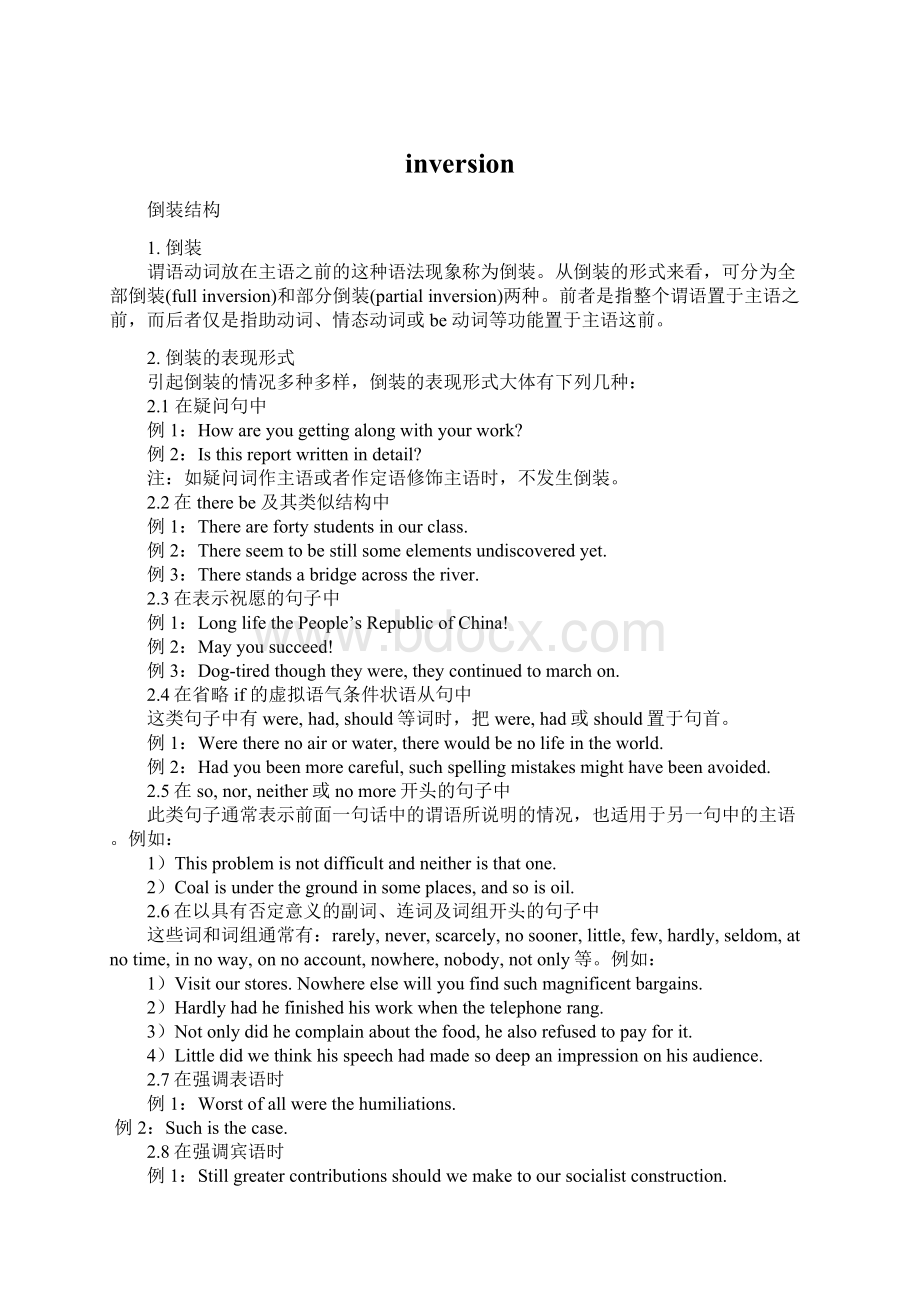inversion.docx
《inversion.docx》由会员分享,可在线阅读,更多相关《inversion.docx(22页珍藏版)》请在冰豆网上搜索。

inversion
倒装结构
1.倒装
谓语动词放在主语之前的这种语法现象称为倒装。
从倒装的形式来看,可分为全部倒装(fullinversion)和部分倒装(partialinversion)两种。
前者是指整个谓语置于主语之前,而后者仅是指助动词、情态动词或be动词等功能置于主语这前。
2.倒装的表现形式
引起倒装的情况多种多样,倒装的表现形式大体有下列几种:
2.1在疑问句中
例1:
Howareyougettingalongwithyourwork?
例2:
Isthisreportwrittenindetail?
注:
如疑问词作主语或者作定语修饰主语时,不发生倒装。
2.2在therebe及其类似结构中
例1:
Therearefortystudentsinourclass.
例2:
Thereseemtobestillsomeelementsundiscoveredyet.
例3:
Therestandsabridgeacrosstheriver.
2.3在表示祝愿的句子中
例1:
LonglifethePeople’sRepublicofChina!
例2:
Mayyousucceed!
例3:
Dog-tiredthoughtheywere,theycontinuedtomarchon.
2.4在省略if的虚拟语气条件状语从句中
这类句子中有were,had,should等词时,把were,had或should置于句首。
例1:
Weretherenoairorwater,therewouldbenolifeintheworld.
例2:
Hadyoubeenmorecareful,suchspellingmistakesmighthavebeenavoided.
2.5在so,nor,neither或nomore开头的句子中
此类句子通常表示前面一句话中的谓语所说明的情况,也适用于另一句中的主语。
例如:
1)Thisproblemisnotdifficultandneitheristhatone.
2)Coalisunderthegroundinsomeplaces,andsoisoil.
2.6在以具有否定意义的副词、连词及词组开头的句子中
这些词和词组通常有:
rarely,never,scarcely,nosooner,little,few,hardly,seldom,atnotime,innoway,onnoaccount,nowhere,nobody,notonly等。
例如:
1)Visitourstores.Nowhereelsewillyoufindsuchmagnificentbargains.
2)Hardlyhadhefinishedhisworkwhenthetelephonerang.
3)Notonlydidhecomplainaboutthefood,healsorefusedtopayforit.
4)Littledidwethinkhisspeechhadmadesodeepanimpressiononhisaudience.
2.7在强调表语时
例1:
Worstofallwerethehumiliations.
例2:
Suchisthecase.
2.8在强调宾语时
例1:
Stillgreatercontributionsshouldwemaketooursocialistconstruction.
例2:
Usefulchemicalfertilizercanwemadefromthewasteliquid.
注:
当前置宾语由“nota+名词”或者“notasingle+名词”构成时,也会引起倒装。
例如:
Alicehadaterribletimetouringthatcountry.Notadaydidshespendwithouthavingsomeunpleasantnesswithwaitersinthehotel.
2.9在强调状语时
(1)当句首状语为方位词或拟声词,谓语动词为go,come等表示位置转移的动词时句子须倒装。
例如:
1)Upwenttheplane.
2)Incamethechairmanandthemeetingbegan.
注:
如果主语是代词则不发生倒装。
例如:
1)Outtheyrushed!
2)Lowerandlowerhebent.
(2)当句首状语为表示地点的介词词组时,句子须倒装。
例如:
1)Roundthecornerwalkedalargepoliceman.
2)Underthetablewaslyingahalf-consciousyoungman.
(3)当句首状语由“only+副词”,“only+介词词组”,“only+状语从句”构成时,句子须倒装。
例如:
1)Onlyyesterdaydidhefindoutthathiswatchwasmissing.
2)Onlybecausethereweresomecancelledbookingsdidhegetsometicketsintheend.
(4)当句首状语为here,there,up,down,out,away,now,then,等时,句子须倒装,主语是代词时,句子不用倒装。
例如:
1)Hereisaticketforyou.
2)Nowcomesyourturn.
3)Herehecomes.
(5)以关联词so(…that)开头的句子中,句子须倒装。
例如:
1)SosmallwasthemarkthatIcouldhardlyseeit.
2)Soquicklydidtheworkmenfinishtheirworkthattheyweregivenabonus.
3)Somuchdoesheworryabouthisfinancialpositionthathecan’tsleepatnight.
注:
在该结构中,“so+形容词”是表语的前置;“so+副词”是状语的前置。
2.10在直接引语之后
在叙事性书面语中,直接引语后常跟askedMary,answeredJohn,saidtheoldlady,gruntedPeter之类的词语。
在这些词语中,动词常的主语之前,主语是代词时,不用倒装。
例如:
1)“Whatdoyoumean?
”askedHenry.
2)“Whatdoyoumean?
”heasked.
2.11often,manyatime等表示频度的状语置于句首时
例如:
Oftendidtheythinkofgoingthere,buttheyneverhadachance.
2.12在as,though引导的让步状语从句中
在as,though引导的让步状语从句中,一般将形容词、副词或名词等置于句首。
例如:
1)Smallastheatomis,wecansmashit.
2)Bigastheworkpieceis,itisturnedoutwith
nomatterhow(who…);however引导的让步状语从句必须采用倒装结构,但不是主谓倒装,而是将被强调的内容置于句首。
如:
Nomatterhowbusyheis,hehastoattendthemeeting
Howevercolditis,healwaysgoesswimming.
It 用法
it的用法以及它与one, that 的辨析是高考题的热点, 应掌握下面的要点。
it为特指, 代单数可数名词,一般代替一个具体的事物,不带修饰成分。
1). 代前面出现过的同名同物的东西, 如:
What's this?
在回答时要用It's a pen. 不再用This is a pen.
2).在语法上代不定式,动名词,从句等,如:
It is important to read aloud when you learn English. 学英语是大声朗读是很重要的。
I think it useless talking with him. 我想给他谈没有用处。
3).it可用在表示时间、距离、天气、温度等的句子里,没有实在的意义。
如:
It is noisy in this room. 这个房间太吵了。
How far is it to New York?
It’s 400 kilometers. 到纽约有多远?
有400公里。
4). it代做某事情的人, 或当性别不明或被认为不重要时,指动物和人, 如:
Someone has broken the window. I think it must be Tom who did it.
有人打坏了窗户,我想肯定是汤姆干的。
Where is the dog?
It is in the other room.狗在哪里?
它在另一间房里。
5). 在疑问句里,it可用来指nothing, everything或all。
如:
Everything has now been said, hasn't it?
一切都交待清楚了,对吗?
常见短语:
★see to it that 注意,留意;关照
★that's it插入语,这正是所需要的
★got it 了解, 懂得
对比:
●one
1). 泛指,代前面出现过的同名异物,复数用ones,可用this/that/each/which及形容词.修饰,也可与冠词连用,或带后置定语。
如:
He has no child, and he wants to adopt one. 他没有孩子,想认养一个。
The new dictionary is quite useful. Why not go to buy one yourself?
这本新字典很有用, 你干吗不去给自己买一本?
I want large ones, not small ones.我要大的,不要小的。
One swallow does not make a summer. 一燕不成夏
2). one 作不定代词时,可以泛指人。
意为;“一个人,一种人” 可数,如:
One should do one's duty. 人人应该尽责。
Modesty helps one to go forward。
谦虚使人进步。
● that
1).代单数可数名词或代不可数名词,只可带后置定语。
只能代替物,不能代替人,但复数those,可指人或物。
在比较状语从句中,特指前面提到的同一类东西,如:
What kind of soup is that?
那是什么汤?
The population of Shanghai is larger than that of Beijing. 北京的人口大于上海。
Those who didn’t pass the exam must stay here for a white.
那些考试不及格的(人), 要留下一会儿。
2). that 用于引导定语从句、状语从句、名词性从句, 强调句. 如:
Did you see the letter that I sent him?
你看到我寄给他的信了吗?
He expressed the hope that we would keep in touch with his firm.
他表示希望我们与他的公司保持联系。
We are glad that we have finished another difficult task.
我们都感到高兴因为又完成了一项艰巨的任务。
It is Mrs. White that makes the decisions in that family. 是怀特夫人在家里说了算吗?
常见短语:
★that+adj.:
=so+adj. 如此, 这样, 如:
I was that angry I could have hit him. 我十分生气, 简直想揍他。
Is the problem that easy?
问题有那么简单吗?
★that is:
=that is to say 即, 就是, 换句话说, 就是说,更确切地说
★in that:
由于, 因为 既然
英语强调句小结
强调句子的方法有四种:
I.倒装结构
1.用在以never,hardly,notonly,nor,seldom,little,rarely,notuntil,hardly…when.
nosooner…than等表示否定意义或半否定意义的副词或词组开头的句子中。
(1)Nosoonerhadhegonetobedthanhefellasleep.
(2)NotonlydidLincolnsettheslavesfree,healsoreunitedthenation.
(3)Notuntiltheearlyyearsofthe19thcenturydidmanknowwhattheheatis.
(4)NotuntilIbegantoworkdidIrealizehowmuchtimeIhadwasted.
(5)Notuntilallthefishdiedintheriverdidthevillagersrealizehowseriousthepollutionwas.
2.表语提前,不仅可以表示强调,而且可使句子结构达到平衡协调,使带有较长修饰语
的主语放到句子的后部,以避免头重脚轻。
(6)Suchisthelittleofourhomeinspacewhenmeasuredupagainstthetotalsubstanceoftheuniverse.
3.从属连词as,however,though等可引出强调让步状语从句,表示非常强烈的对照。
(7)Busyashealwaysis,Bobneverrefusestohelpothers.
(8)Howeverlatesheis,motherwillwaitforhimtohavedinnertogether.
4.当only与它所修饰的状语一起位于句首时,须用倒装语序,only起强调作用。
其句形为“only+状语+部分倒装语序”。
(9)OnlyinthiswaycanyoumakeprogressinyourEnglish.
II.It引出强调结构
一、考查强调结构的基本形式
强调结构的基本形式是“Itis/was+被强调部分+that/who...”,可以用来强调主语、宾语、状语等,一般不能强调谓语动词。
[原题再现]
Itistheabilitytodothejob________matters,notwhereyoucomefromorwhatyouare.
A.oneB.thatC.whatD.it
答案:
B
二、考查一般疑问句的强调结构
一般疑问句的强调结构句型为:
Is/Wasit+被强调部分+that/who...?
[原题再现]
Was________thatIsawlastnightattheconcert?
A.ityouB.notyouC.youD.yourself
答案:
A
三、考查特殊疑问句的强调结构
特殊疑问句的强调结构句型为:
特殊疑问词(Who/What/When/Where/Why/How...)+is/wasitthat...?
例如:
WhywasitthatLiLeicamelateagain?
这类强调结构置于从句中时应使用陈述语序:
Thequestioniswhoitisthatwecantrust.
[原题再现]
Ihavealwaysbeenhonestandstraight-forward,anditdoesn’tmatter________I’mtalkingto.
A.whoisitB.whoitisC.itiswhoD.itiswhom
答案:
B
四、考查对not...until...句式的强调
对not...until...句式的强调有固定的句型,即Itis/wasnotuntil...that...。
[原题再现]
Itwasnot________shetookoffherdarkglasses________Irealizedshewasafamousfilmstar.
A.when;thatB.until;thatC.until;whenD.when;then
答案:
B
五、考查强调句型的反意疑问句及回答
强调句型的反意疑问句及回答应与Itis/was...that...结构保持一致。
[原题再现]
—Wasn’titDr.Wangwhospoketoyoujustnow?
—________.
A.Ididn’tknowhewasB.Yes,itwasC.No,hewasn’tD.Yes,hedid
答案:
B
六、考查强调结构与其它相似结构的区别
强调结构与其它含有it的结构非常相似,很容易混淆。
区别的办法是去掉Itis/was...that...结构后,句子依然成立的是强调结构。
[原题再现]
Itwasevening________wereachedthelittletownofWinchester.
A.thatB.untilC.sinceD.before
答案:
D
III.双重否定结构
双重否定结构是由否定词not,never,nobody,nothing等与带否定意义的词或词组相配合而构成的。
双重否定即否定的否定,实质是肯定,而且语气较为强烈。
Oneisnevertoooldtolearn.
Idon’tthinkitpossibletomasteraforeignlanguagewithoutmuchmemorywork.
Withoutknowledgeofscienceandtechnology,itisimpossibletobuildourcountryintoastrongandsocialistcountry.
Unlesshecomes.Wewon’tbeabletogo.
IV.Do(does/did)引出强调句
1.在肯定句的谓语动词之前(通常是现在时和过去时的肯定句), 可用助动词do(does/did) 来
强调动词,这时谓语动词须用原形动词。
Do(does/did)可译成“确实”“的确”。
Tomygreatjoy,,theplantdidlookexactlylikewhatwewerelookingfor.
Hedoesworkhardandfinishthejobintime.
2.在肯定的祈使句中,用动词do来加强语气,可译成“务必,一定,千万”
Docomeandseeussomeday.
Dogivehermyregards.
倒装练习
一、单选题
1.Onlywhenyouhaveobtainedsufficientdata______cometoasoundconclusion.
A.canyouB.youcanC.wouldyouD.youwould
2.______thatthisregionwassorichinnaturalresources.
A.LittleheknewB.LittledidheknowC.LittlehedidknowD.Littlehehadknown
3.Neveragain______politicalofficeafterhis1928defeatforthepresidency.
A.AlfredE.SmithseriouslysoughtB.seriouslyAlfredE.Smithsought
C.whendidAlfredE.SmithseriouslyseekD.didAlfredE.Smithseriouslyseek
4.Onlyinrecentyears______beguntorealizethatwilddogs,keptwithinbounds,oftendomoregoodthanharm.
A.peoplehaveB.sincepeoplehaveC.havep